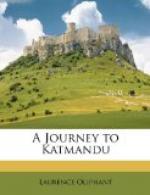A peak of the gigantic Himaleh, bursting through the bank of clouds which had hitherto obscured it, reared its snow-capped summit far up towards the skies, and completed this noble prospect.
Crossing the river, we proceeded to visit the temple sacred to Bhood, the resort of the numerous tribes of Bhootiyas, or inhabitants of the highlands of Thibet and Chinese Tartary, who perform annual pilgrimages hither in the winter, but are obliged to return to their homes early in the spring, being unable to endure the heat of a Nepaulese summer.
This remarkable building was visible some time before we reached it, and is of the form peculiar to Bhuddist places of worship in other parts of the world, but more particularly in Anuradhupoora and the ancient cities of Ceylon, the ruins of which bear testimony to the existence of larger Dagobas than that before which the followers of the Bhuddist faith worship in the valley of Katmandu.
The pyramidal summit was gorgeously gilt, and terminated in a huge bell adorned in the same glittering manner, producing a brilliant effect as it brightly reflected the rays of the noonday sun. The massive stone platform on which the Dagoba stood was square; the ascent to it on each side was by a broad flight of steps, but, on the lower part of the pyramid, staring Chinese-looking eyes, painted in brilliant colours, detracted considerably from the imposing effect which a massive pile of stone and brick, not less than 120 feet high, would otherwise have produced.
We rode round it in a sort of court-yard, enclosed by small two-storied houses, which were very filthy, and out of which emerged men, women, and children, very filthy also; we were soon encompassed by a crowd of the most disreputable, dissolute-looking wretches imaginable. The women were dressed in thick woollen gowns, which had once been red, and reached a little below the knee; these were loosely fastened round the waist, remaining open or closed above as the case might be. The children, notwithstanding the inclement temperature, were in the cool and airy costume common to the rising generation in the East. The men were dressed exactly like the women; their matted hair and beard, flat noses, and wide eyes, generally bloodshot, giving them a disgusting appearance. Both sexes wore a sort of woollen gaiter, open at the calf, the protruding muscle of which looked as if nothing could have confined it; their shoes, as far as the dust would allow me to see, were of the same material. They seemed good-natured and inoffensive, but are not free from the vice of drunkenness; they consume quantities of tea prepared with rancid lard.
Had I been asked to determine the origin of this race, I should have pronounced it to be a mixture of Naples lazzaroni with the scum of an Irish regiment. The ruddy complexions of some of the women, and the swarthy look of many of the men, might fairly warrant such a conclusion. They were so importunate and offensive as they pressed round me that I hurried over my sketch of the temple, and made my escape from them, not, however, without once more looking round with interest on the crowd of beings whose distant habitations were upon the northern slope of the Himalayan chain, hitherto unvisited by any European, except Dr. Hooker, and consequently almost totally unknown.




